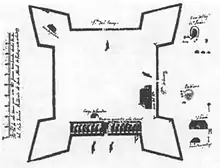Laureano de Torres y Ayala | |
|---|---|
| 30th Governor of La Florida | |
| In office 21 September 1693 – 1699 | |
| Preceded by | Diego de Quiroga y Losada |
| Succeeded by | José de Zúñiga y la Cerda |
| 42nd Governor of Cuba | |
| In office January 18, 1708 – February 18, 1711 | |
| Preceded by | Pedro Álvarez de Villarín |
| Succeeded by | Vicente de Raja |
| Personal details | |
| Born | 1645 Seville, Spain |
| Died | 1722 (aged 77) Havana, Cuba |
| Spouse |
Catalina Gertrudis Bayona y Chacón
(m. 1687) |
| Children | 3 |
| Profession | Soldier Governor |
Laureano de Torres y Ayala (1645–1722), Marquis of Casa Torres and Knight of Santiago,[1] was a Spanish military officer and royal governor of La Florida (1693–1699) and of Cuba (1708–1711 and 1713–1716). During his administration in Florida, he completed the construction of the Castillo de San Marcos fortress in St. Augustine (San Agustín), the provincial capital.
Biography
Laureano José de Torres Ayala a Duadros Castellanos was born in 1645 in Seville, Spain,[2] and grew up in Madrid, where his parents settled when he was still a small child. Ayala came from a noble family, being the son of Tomás de Torres y Ayala and Elvira de Quadros Castellanos.[2] His father was a judge in Seville in 1649 and mayor, governor and Captain General of Mérida and La Grita (in Venezuela). He had three brothers: Pedro Ignacio, Cristóbal and Diego Torres Ayala y Quadros. In his youth he joined the Spanish army.
In June 1693, Ayala joined a Spanish expedition in La Florida which passed through what is now Okaloosa County[3] and crossed the natural bridge of the spring-fed Chipola River. On September 21, 1693, Torres y Ayala was appointed Governor of Spanish Florida, replacing Diego de Quiroga y Losada.[4]
Like the previous governors since 1672, Torres y Ayala oversaw construction of the Castillo de San Marcos, completed in 1695.[5] During his administration, the San Carlos de los Chacatos mission was attacked by Alibamu Indian warriors in 1696.[6] In 1698, the first European settlement (Presidio Santa Maria de Galve) and the first fort (Fort San Carlos de Austria) were founded at the site of present-day Pensacola.[7] He held the post of governor of Florida until 1699, when he returned to Spain, being replaced by José de Zúñiga y la Cerda.[4]

Between 1704 and 1707, Ayala fought in the War of the Spanish Succession in Europe.[8] On January 18, 1708, Ayala was appointed Governor General of Cuba, and worked mainly at Havana, where he was principally concerned with the island's economic problems and defenses. A Spanish official and landowner, Orri, had proposed a project to sell tobacco for the Cuban government. Ayala thought that the idea would be advantageous to Spain and lent the plan his full support, but had to contend with the opposition of the speculators who legally bypassed customs duties when they shipped tobacco to other ports in America and Spain. The government tobacco monopoly was very successful, and Ayala was rewarded with the title of Marquis de Casa-Torre, notwithstanding his disputes with Lieutenant-auditor Jose Fernandez de Córdoba.[1]
On February 18, 1711, the oidor (judge of the Real Audiencia) Pablo Cavera had Ayala temporarily suspended while the matter was investigated. After sailing to Spain to explain his case, Ayala was reinstated as governor of Cuba on February 14, 1713. The administration of Governor Ayala was a period of relative peace. On June 9, 1714, he ordered the construction of a hospital for lepers in Havana; after collecting several large donations, he began construction of the Hospital de San Lazaro and its church on a plot located near Havana city. Ayala founded the city of Santiago del Bejucal. The tobacco industry expanded greatly during his governorship, and the tobacco plant began to be widely cultivated in the Vuelta Abajo district.
Personal life
Laureano de Torres y Ayala married the Cuban Catalina Gertrudis Bayona y Chacón on August 5, 1687 in Havana.[9] He had three children: Tomasa María, Laureano Antonio José, and Sor Manuela de San Laureano.
References
- 1 2 Johnson, Willis Fletcher (1920). The History of Cuba. Vol. 1. B. F. Buck & Company. p. 334. Retrieved February 7, 2017.
- 1 2 3 "Laureano de TORRES AYALA Y QUADROS, I marqués de Casa Torres". Darrin Lythgoe. 2015. Retrieved March 30, 2018.
- ↑ "Florida Counties". State of Florida, Dept. of Agriculture, N. Mayo, commissioner. Tallahassee. 1944. Retrieved March 30, 2018.
- 1 2 Cahoon, Ben. "U.S. States F-K". Retrieved March 30, 2018.
- ↑ United States. National Park Service. Division of Publications (1993). Castillo de San Marcos: a guide to the Castillo de San Marcos National Monument, Florida. U.S. Dept. of the Interior. p. 22. ISBN 978-0-912627-59-5.
- ↑ Dox, Dale. "Jackson County, Florida Historic Sites and Research:San Carlos de Chacatos". Explore Southern History. Retrieved April 22, 2010..
- ↑ "Fort Barrancas". National Park Service. 2006. Archived from the original on February 25, 2015. Retrieved August 2, 2015.
- ↑ Cox, Dale (2011). "The Spanish at Florida Caverns State Park. A Legacy of Soldiers and Priests". Explore Southern History. Retrieved March 30, 2018.
- ↑ de Cárdenas Piera, Emilio; de Cadenas y Vicent, Vicente (1994). Caballeros de la Orden de Santiago, siglo XVIII. Vol. 5. Madrid: Ediciones Hidalguía. p. 34. ISBN 9788487204616.
External links
- – Governor of Cuba, (in Spanish)